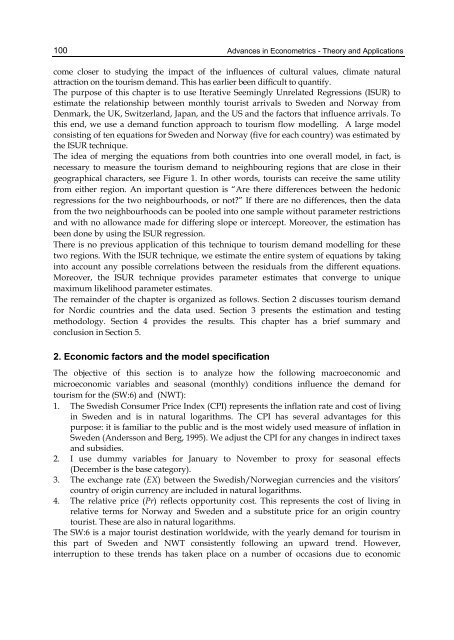The Limits of Mathematics and NP Estimation in ... - Chichilnisky
The Limits of Mathematics and NP Estimation in ... - Chichilnisky
The Limits of Mathematics and NP Estimation in ... - Chichilnisky
- No tags were found...
Create successful ePaper yourself
Turn your PDF publications into a flip-book with our unique Google optimized e-Paper software.
100Advances <strong>in</strong> Econometrics - <strong>The</strong>ory <strong>and</strong> Applicationscome closer to study<strong>in</strong>g the impact <strong>of</strong> the <strong>in</strong>fluences <strong>of</strong> cultural values, climate naturalattraction on the tourism dem<strong>and</strong>. This has earlier been difficult to quantify.<strong>The</strong> purpose <strong>of</strong> this chapter is to use Iterative Seem<strong>in</strong>gly Unrelated Regressions (ISUR) toestimate the relationship between monthly tourist arrivals to Sweden <strong>and</strong> Norway fromDenmark, the UK, Switzerl<strong>and</strong>, Japan, <strong>and</strong> the US <strong>and</strong> the factors that <strong>in</strong>fluence arrivals. Tothis end, we use a dem<strong>and</strong> function approach to tourism flow modell<strong>in</strong>g. A large modelconsist<strong>in</strong>g <strong>of</strong> ten equations for Sweden <strong>and</strong> Norway (five for each country) was estimated bythe ISUR technique.<strong>The</strong> idea <strong>of</strong> merg<strong>in</strong>g the equations from both countries <strong>in</strong>to one overall model, <strong>in</strong> fact, isnecessary to measure the tourism dem<strong>and</strong> to neighbour<strong>in</strong>g regions that are close <strong>in</strong> theirgeographical characters, see Figure 1. In other words, tourists can receive the same utilityfrom either region. An important question is “Are there differences between the hedonicregressions for the two neighbourhoods, or not?” If there are no differences, then the datafrom the two neighbourhoods can be pooled <strong>in</strong>to one sample without parameter restrictions<strong>and</strong> with no allowance made for differ<strong>in</strong>g slope or <strong>in</strong>tercept. Moreover, the estimation hasbeen done by us<strong>in</strong>g the ISUR regression.<strong>The</strong>re is no previous application <strong>of</strong> this technique to tourism dem<strong>and</strong> modell<strong>in</strong>g for thesetwo regions. With the ISUR technique, we estimate the entire system <strong>of</strong> equations by tak<strong>in</strong>g<strong>in</strong>to account any possible correlations between the residuals from the different equations.Moreover, the ISUR technique provides parameter estimates that converge to uniquemaximum likelihood parameter estimates.<strong>The</strong> rema<strong>in</strong>der <strong>of</strong> the chapter is organized as follows. Section 2 discusses tourism dem<strong>and</strong>for Nordic countries <strong>and</strong> the data used. Section 3 presents the estimation <strong>and</strong> test<strong>in</strong>gmethodology. Section 4 provides the results. This chapter has a brief summary <strong>and</strong>conclusion <strong>in</strong> Section 5.2. Economic factors <strong>and</strong> the model specification<strong>The</strong> objective <strong>of</strong> this section is to analyze how the follow<strong>in</strong>g macroeconomic <strong>and</strong>microeconomic variables <strong>and</strong> seasonal (monthly) conditions <strong>in</strong>fluence the dem<strong>and</strong> fortourism for the (SW:6) <strong>and</strong> (NWT):1. <strong>The</strong> Swedish Consumer Price Index (CPI) represents the <strong>in</strong>flation rate <strong>and</strong> cost <strong>of</strong> liv<strong>in</strong>g<strong>in</strong> Sweden <strong>and</strong> is <strong>in</strong> natural logarithms. <strong>The</strong> CPI has several advantages for thispurpose: it is familiar to the public <strong>and</strong> is the most widely used measure <strong>of</strong> <strong>in</strong>flation <strong>in</strong>Sweden (Andersson <strong>and</strong> Berg, 1995). We adjust the CPI for any changes <strong>in</strong> <strong>in</strong>direct taxes<strong>and</strong> subsidies.2. I use dummy variables for January to November to proxy for seasonal effects(December is the base category).3. <strong>The</strong> exchange rate (EX) between the Swedish/Norwegian currencies <strong>and</strong> the visitors’country <strong>of</strong> orig<strong>in</strong> currency are <strong>in</strong>cluded <strong>in</strong> natural logarithms.4. <strong>The</strong> relative price (Pr) reflects opportunity cost. This represents the cost <strong>of</strong> liv<strong>in</strong>g <strong>in</strong>relative terms for Norway <strong>and</strong> Sweden <strong>and</strong> a substitute price for an orig<strong>in</strong> countrytourist. <strong>The</strong>se are also <strong>in</strong> natural logarithms.<strong>The</strong> SW:6 is a major tourist dest<strong>in</strong>ation worldwide, with the yearly dem<strong>and</strong> for tourism <strong>in</strong>this part <strong>of</strong> Sweden <strong>and</strong> NWT consistently follow<strong>in</strong>g an upward trend. However,<strong>in</strong>terruption to these trends has taken place on a number <strong>of</strong> occasions due to economic








